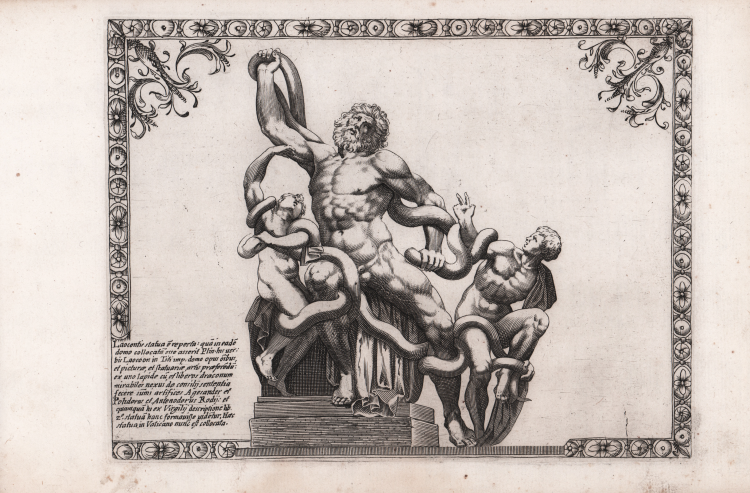




| Reference: | S20260 |
| Author | Giacomo LAURO |
| Year: | 1615 ca. |
| Measures: | 235 x 180 mm |



| Reference: | S20260 |
| Author | Giacomo LAURO |
| Year: | 1615 ca. |
| Measures: | 235 x 180 mm |
Etching and engraving, ca. 1615/30, lacking signature and printing details.
Magnificent proof, impressed on contemporary laid paper, with margins, in perfect condition.
Anonymous, very rare depiction of the sculptural group of the Looconte, surrounded by an engraved ornamental frame, which we attribute to the hand of Giacomo Lauro for stylistic reasons and for its - occasional - presence in Lauro's collection Antiquae urbis splendor, a work of great historical and archaeological importance that the author began in 1612.
An example of the work - later and lacking the ornamental frame - is present in the print collection of the Istituto Centrale per la Grafica - Fondo Corsini – described as belonging to a "Collection of ancient statues of Rome," printed with Giovan Battista De Rossi's address and dated 1641.
https://www.calcografica.it/stampe/inventario.php?id=S-FC291#&gid=1&pid=S-FC291
The Corsinian example, in addition to lacking the ornamental frame, is evidently later and retouched; therefore, our proof is definitely earlier than 1641.
The Antiquae urbis splendor by Giacomo Lauro has a long and varied history of publishing, beginning in 1612, though Lauro’s work on the book predates its publishing by at least eighteen years. The book was first printed by Giacomo Mascardi, and it originally only contained two parts, though by 1615 it had expanded to a third part. The first part contained 37 engravings, with a dedication to King Sigismund III of Poland, dated 1614, and a portrait dated 1609 (borrowed from another book of engravings). The second part contained a portrait of Charles Emmanuel I, Duke of Savoy, dated 1613, and 41 engravings. It is worth noting that these first two books were both dedicated to Polish nobility, probably due to the fact that Lauro had enjoyed patronage from engraving Polish battles early in his career. The third part, added later, was dedicated to Ranuccio Farnese, one of Lauro’s greater patrons later in his life, and contained 40 engravings.
The number of plates included in each of the earlier editions of Lauro’s work (printed at the Camera Apostolica in 1614 in four parts, and printed there again in 1621 in three parts) was finally settled in 1628 with the addition of the fourth and final book for a total of 166 engravings, which is the generally accepted number for how many engravings total Lauro produced for this work. The edition published by Vitale Mascardi and curated by Giovanni Alto was released in 1637. Alto added a final index and numbered each of the engravings, 2-167, for this latest release.
The present work is not included in the index compiled by Alto and it is likely, therefore, that it was not chosen for the work, in which it may only occasionally have been included, along with a depiction of the Holy House of Loreto, with a similar decorative layout
https://www.antiquarius.it/it/-loreto-/3151-facciata-della-chiesa-della-madonna-di-loreto.html
A very rare work. Undescribed.
|
Engraver, printer and print publisher. Active in Rome from 1583. 17 March 1598 he applied for and was granted a ten-year papal privilege for an unspecified number of unnamed religious prints.
Lauro’s earliest dated prints are of 1585, and carry the address of C. Duchetti. He also worked for Panzera in 1589. From 1590 he tried to establish himself as a publisher of his own work. He acquired and restored old plates, published copies of such classic prints as Marcantonio’ St.Paul preaching . He accepted commissions, as the map of Rocca Contrada, 1594.
He probably acquired plates from Jacob Matham which he published in 1598. His Antiquae Urbis Splendor was published in parts from 1612. In the volumes issued in 1614 and 1615 Lauro refers to having worked on it for 28 years which would mean that he began it about 1586. Important connections with Poland; he specialized in images of saints.
|
|
Engraver, printer and print publisher. Active in Rome from 1583. 17 March 1598 he applied for and was granted a ten-year papal privilege for an unspecified number of unnamed religious prints.
Lauro’s earliest dated prints are of 1585, and carry the address of C. Duchetti. He also worked for Panzera in 1589. From 1590 he tried to establish himself as a publisher of his own work. He acquired and restored old plates, published copies of such classic prints as Marcantonio’ St.Paul preaching . He accepted commissions, as the map of Rocca Contrada, 1594.
He probably acquired plates from Jacob Matham which he published in 1598. His Antiquae Urbis Splendor was published in parts from 1612. In the volumes issued in 1614 and 1615 Lauro refers to having worked on it for 28 years which would mean that he began it about 1586. Important connections with Poland; he specialized in images of saints.
|